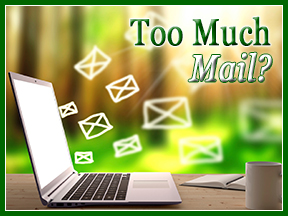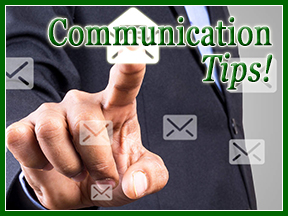 We all have mail, way too much mail. This ezine is devoted to answering the question “How do you find the balance between being an effective communicator and nuisance?” As I was writing this ezine, I received a series of emails that exemplify worst practice in email communication. The example provided is meant to illustrate what email practices to avoid. It is not intended to be mean-spirited. I will also offer guidelines for best email practices.
We all have mail, way too much mail. This ezine is devoted to answering the question “How do you find the balance between being an effective communicator and nuisance?” As I was writing this ezine, I received a series of emails that exemplify worst practice in email communication. The example provided is meant to illustrate what email practices to avoid. It is not intended to be mean-spirited. I will also offer guidelines for best email practices.
#1. We now accept tuition via major credit cards. Hit administrational in the lower left- hand corner, then hit payment, click on tuition, hit credit card option…
#2. Our dinner committee is in full swing. Call to volunteer (no email address, just a phone number.)
#3. We received a matching grant for laptops from an anonymous donor. It expires in 45 days. To contribute, please call … (again no email address, just a phone number.)
As a non-parent, non-tuition paying constituent, the first email was definitely irrelevant. I also had minimal interest in the second message, “been there, done that,” flitting through my mind. Yet, it is certainly appropriate to encourage readers to volunteer. The third memo, well… if I hadn’t been mildly annoyed by the first two irrelevant emails, perhaps I would have been more inclined to contribute. The matching grant wasn’t expiring for another 45 days. There was no urgency and no need to bombard the already overloaded parent with yet another email in the same night.
Unfortunately, within the hour I received:
#4. A Shiva notice.
It was enough to make me unsubscribe.
 So, how should a school communicate all of the above without annoying its constituents? Read on to see how to incorporate email into your overall communications plan.
So, how should a school communicate all of the above without annoying its constituents? Read on to see how to incorporate email into your overall communications plan.
A plan might feature a weekly email, a quarterly or semi-annual newsletter, a phone dialing (or parent chain) system, and if appropriate for your staff and parents, social networking.
A weekly email to parents makes sense for most day schools.
This should be a short update. Don’t fall into the trap of more is better. I’ve seen weekly newsletters morph from lively and informative two-pagers into monstrous 24-page magazines. In terms of weekly correspondence: less is more!
What should your newsletter-email include?
![]() One or two articles about secular news
One or two articles about secular news
![]() One or two articles about Jewish studies
One or two articles about Jewish studies
![]() A one-paragraph Dvar Torah or educational message
A one-paragraph Dvar Torah or educational message
![]() Any timely announcements
Any timely announcements
![]() Some happy pictures
Some happy pictures
![]() Exceptional school news
Exceptional school news
Remember, your weekly email newsletter should be a strategic vehicle for achieving specific goals. You know what your parents’ concerns are, so feature articles that will alleviate those concerns. For additional information in crafting an educational and illuminating newsletter that the parent may just read, please request the article “What Should your School Newsletter Do for You.”
Daily Email Guidelines
#1. Segment your list
Take the time to segment your list. Sub-groups may include: current parents, alumni parents, alumni, grandparents, donors, potential donors, and vendors. Many of these groups, particularly the current parent group, can be divided further.
#2. Give them What They Want – not What You Want Them to Want
It’s very tempting to send all your news to all your constituents.
I would love to have all my seventh-grade parents know everything about my high school. I would like them to know not only about the school’s mission but also the multitude of ways it achieves that mission. After all, when they choose a high school, all cumulative knowledge helps them make an informative decision.
Don’t succumb to the temptation. Most people want important and timely information. For everything else, there is a delete button.
(Think about it: Does a third-grade parent who is busy with work, after-school carpools, and a plan to get to the drycleaners before they close, really want to open an “important notice from school” email about the SAT deadline? Does the high school parent care about lice in the elementary school (if the buildings are totally separate?)
How do you find out what they want? Ask!
Some parents might want a weekly Shabbat email with a Dvar Torah. Grandparents might want one too. Ask if they would like to subscribe to your Shabbat list. Ask the alumna who was superstar athlete if she wants updates about the basketball team. These practices build goodwill. Constituents will actually look forward to rather than dread your emails!
#3. Appoint a Message Monitor. This is one person who has the final authority over the send button.
You may have multiple messages and each, of course, is important. But, barring emergencies, people need to communicate with each other about upcoming messages so the “message monitor” can plan an effective calendar. Otherwise, educational, administrative, and fundraising emails may end up in the recycle bin as a result of constituents email overload!
My team and I are here to help you communicate effectively, increase visibility and loyalty, recruit and retain students, and raise important funds. If you would like to chat about your needs, please send me an email or call 516.569.8070.
Kol tuv,
Candace Plotsker-Herman


